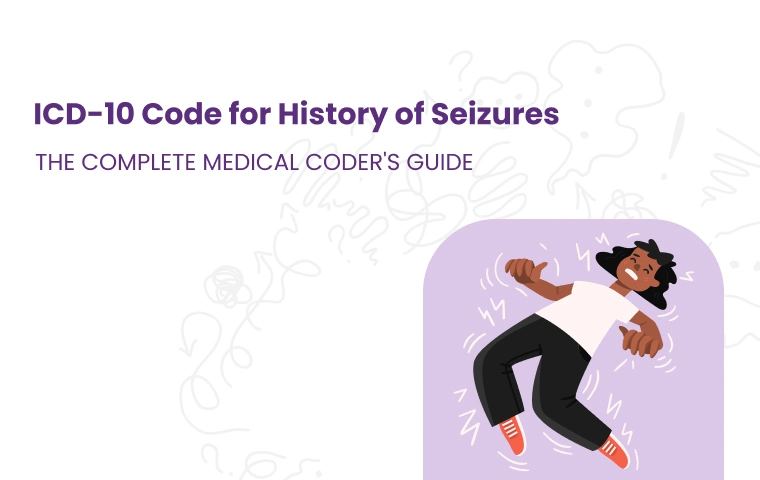If you code seizure conditions, you know the stakes. Mixing up an active seizure disorder with a resolved seizure history can ripple through risk profiles, care plans, and payments. The right call turns on detail, not guesswork.
That is why the correct use of history Z codes matters. In ICD 10 code for personal history codes captures conditions that no longer exist and are not being treated, yet still influence care. They are allowed when the record shows resolution and continued clinical relevance.
Accurate Z code assignment supports safer anesthesia choices, medication reviews, and proactive care coordination. It also keeps claims clean, minimizes denials, and prevents over or underestimation of patient risk by separating historical disease from current disease.
The official guidelines clarify that a history code is usually secondary to the reason for the encounter, except when the encounter itself is for the history or for follow up.
What You'll Master in This Guide
-
Exact code selection for history of seizures ICD 10
-
Documentation elements that satisfy auditors
-
Clear distinctions between history and active epilepsy
-
Common coding pitfalls and prevention strategies
-
Real-world scenarios with coding solutions
The Primary Code: Z86.69 Personal History of Seizures
Z86.69 - Personal history of other diseases of the nervous system and sense organs is your go-to code for documented seizure histories when specific conditions are met. This code belongs to the Z86 category for personal history of certain other diseases within the broader Z chapter covering factors influencing health status
Key Classification Details:
-
Parent category: Z86 - Personal history of certain other diseases
-
Specific subcategory: Z86.6 - Personal history of diseases of the nervous system and sense organs
-
Clinical purpose: Captures resolved seizure conditions with ongoing clinical relevance
When to Assign Z86.69
Assign Z86.69 when your documentation supports all three criteria:
-
Prior seizure history: The patient previously had seizures or epilepsy
-
Condition resolved: No longer exists and isn't the reason for current treatment
-
Clinical relevance: Potential ongoing impact on medication interactions, anesthesia planning, or counseling
Critical Distinction: If seizures are ongoing or the patient remains on active anticonvulsant therapy for seizure control, use active epilepsy codes from the G40 series instead.
Documentation Requirements That Defend Your Coding
Essential Elements for Z86.69:
-
Date of last seizure and seizure-free duration
-
Medication history with start/stop dates
-
Clear provider statement of resolution or remission
-
Supporting test results (EEG interpretations when available)
Active Epilepsy vs. Seizure History
When to Use G40 Series (Active Epilepsy Codes)
Choose G40 codes when patients have current epilepsy or recurrent seizures requiring active management. The G40 category includes multiple subtypes with specific coding requirements:
Common G40 Applications:
-
Focal epilepsy: G40.1 and G40.2 groups with intractability options
-
Generalized idiopathic epilepsy: G40.30 series
-
Other generalized epilepsy: G40.40x and G40.41x with status options
-
Status epilepticus: Captured within G40 subcodes or separate G41 category
Critical Decision Points for Code Selection
|
Clinical Scenario |
Coding Decision |
Code Selection |
|
Currently taking anticonvulsants for seizure control |
Active epilepsy |
Appropriate G40 code |
|
Recent seizure activity within treatment period |
Active condition |
G40 code by type and status |
|
Seizure-free but under neurologic monitoring |
Clinical judgment required |
Z86.69 if resolved, G40 if ongoing disease |
|
Pediatric febrile seizures only |
Not epilepsy |
R56.0 for febrile convulsions |
Pro Tip: Use the guideline principle of coding to the highest degree of certainty supported by your documentation.
Real-World Coding Scenarios: From Theory to Practice
Scenario 1: Childhood Epilepsy Resolution
Patient: 22-year-old presenting for sports physical
History: Childhood absence epilepsy treated ages 8-11, seizure-free since age 11, therapy stopped at age 12
Correct Coding: Z86.69 as personal history
Documentation Must-Haves: Last seizure date, therapy stop date, clinician attestation of resolution
Scenario 2: Post-Traumatic Seizures (Resolved)
Patient: 40-year-old with remote post-traumatic seizures
Status: Completed therapy, seizure-free for 5 years, routine care visit
Sequencing Strategy: Primary diagnosis reflects today's visit reason, add Z86.69 for seizure history. If surveillance follow-up after completed treatment, use Z09 first, then Z86.69.
Scenario 3: Single Seizure Event
Patient: 28-year-old with one convulsive event 6 months ago
Current Status: No recurrence, evaluation inconclusive
Coding Approach: R56.9 (Unspecified convulsions) when documentation reflects convulsive event without established epilepsy diagnosis. Avoid labeling as epilepsy history.
Scenario 4: Pre-Anesthesia Clearance
Patient: Older adult for colonoscopy clearance
History: Remote seizure history, no therapy for decade
Secondary Reporting: Use Z86.69 as additional diagnosis—influences medication and anesthesia planning despite unrelated primary reason for encounter.
Advanced Documentation Guidelines
Clarification Targets:
-
Ambiguous phrases like "old seizures" lacking timing specifics
-
Missing last seizure dates
-
Anticonvulsants on medication lists without context
-
Conflicts between problem lists and narrative notes
Best Practice: Follow AHIMA and ACDIS guidance for compliant, non-leading queries with clinical support.
Supporting Documentation Sources
Primary References:
-
Neurology consults and follow-up notes
-
Medication reconciliation records
-
Discharge summaries and care transition documentation
-
EEG or neuroimaging reports when available
Compliance Foundation: Maintain clear links between diagnoses and services rendered for audit readiness.
Reimbursement and Payer Considerations
Medicare Guidelines and Sequencing
Z Code Positioning:
-
Primary position: When visit is specifically for follow-up after completed treatment (sequence Z09 first, then Z86.69)
-
Secondary position: History code after condition chiefly responsible for visit
Medical Necessity: Local Coverage Determinations may list seizure-related diagnoses for diagnostic service authorization. Confirm current LCD requirements for your jurisdiction.
Risk Adjustment Impact
Key Insight: Risk adjustment models capture ongoing disease burden, not resolved conditions. Active epilepsy codes (G40 series) typically map to HCC risk categories, while personal history codes like Z86.69 generally don't adjust risk independently.
Related Codes and Clinical Connections (Associated ICD-10 Codes for Comprehensive Coding)
|
Code |
Application |
Clinical Context |
|
R56.9 |
Unspecified convulsions |
Single convulsive event without epilepsy diagnosis |
|
Z86.61 |
Personal history of CNS infections |
Prior meningitis/encephalitis explaining seizure history |
|
F44.5 |
Conversion disorder with seizures |
Psychogenic non-epileptic events |
|
Z09 |
Follow-up examination after treatment |
Surveillance visits after completed seizure therapy |
Exclusions and Coding Conflicts to Avoid
Never Combine:
-
Z86.69 with active G40 epilepsy code for same condition at same encounter
-
Psychogenic non-epileptic events with epilepsy codes (use F44.5 instead)
-
History codes when patient remains on active anticonvulsant therapy
Best Practices Checklist
Before assigning Z86.69, verify these 10 elements:
✅ Prior seizure disorder or epilepsy diagnosis documented
✅ Record states condition no longer exists/resolved
✅ Patient off anticonvulsant therapy for seizure control
✅ Last seizure date stated or inferable
✅ Seizure-free interval recorded
✅ Provider attestation of resolution/remission present
✅ Proper sequencing for surveillance visits (Z09 first)
✅ No active neurologic signs justifying G40 code
✅ Considered R56.9 for undifferentiated convulsions
✅ Relevant comorbid history codes identified and supported
Time-Saving Documentation Review Strategies
Quick Assessment Approach:
-
Scan medication timeline first - One discontinuation note can resolve history vs. active question instantly
-
Check neurology notes for key phrases - Look for "resolved," "remission," or "seizure-free since [date]"
-
Verify problem list accuracy - Lists often lag behind clinical reality
Staying Current: 2025 Updates and Future Considerations
Recent ICD-10-CM Changes
-
Z86.69 retained its description for fiscal year 2025
-
New additions include personal history of polyps and KCNQ2-related epilepsy codes in G40 series
-
Automation considerations: AI-assisted coding tools require explicit documentation of resolution dates and medication status
Professional Development Priorities
Key Focus Areas:
-
Annual ICD-10-CM updates each October
-
G40 series refinements and new epilepsy subtypes
-
Enhanced documentation template development
-
Compliance with evolving audit standards
Conclusion
Z86.69 serves as the precise tool for personal history of seizures when conditions have resolved and active treatment has ended. Success depends on clear documentation telling the complete story: last seizure date, therapy discontinuation, and explicit resolution statements.
Remember the sequencing rules:
-
Surveillance visits: Z09 first, then Z86.69
-
Other visits: Z86.69 after primary reason for encounter
This guideline-backed approach ensures accurate seizure history coding while supporting optimal patient care and financial outcomes.
Essential Resources for Continued Excellence
Professional References:
-
CMS ICD-10-CM Official Guidelines for Coding and Reporting (2025)
-
AAPC code references for G40 epilepsy categories
-
AHIMA practice briefs on compliant query development
-
CMS Beneficiary Notices Initiative for ABN requirements
ABOUT AUTHOR

Pedro Collins
As a blog writer with years of experience in the healthcare industry, I have got what it takes to write well-researched content that adds value for the audience. I am a curious individual by nature, driven by passion and I translate that into my writings. I aspire to be among the leading content writers in the world.
